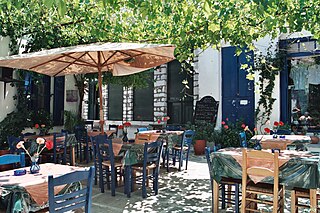
Greek cuisine is the cuisine of Greece and the Greek diaspora. In common with many other cuisines of the Mediterranean, it is founded on the triad of wheat, olive oil, and wine. It uses vegetables, olive oil, grains, fish, and meat, including pork, poultry, veal and beef, lamb, rabbit, and goat. Other important ingredients include pasta, cheeses, lemon juice, herbs, olives, and yogurt. Bread made of wheat is ubiquitous; other grains, notably barley, are also used, especially for paximathia. Common dessert ingredients include nuts, honey, fruits, and filo pastries. It continues traditions from Ancient Greek and Byzantine cuisine, while incorporating Ottoman, Middle Eastern, Balkan and Italian influences.

Olive oil is a liquid fat obtained from olives, a traditional tree crop of the Mediterranean Basin, produced by pressing whole olives and extracting the oil. It is commonly used in cooking, for frying foods or as a salad dressing. It is also used in cosmetics, pharmaceuticals, and soaps, and as a fuel for traditional oil lamps, and has additional uses in some religions. The olive is one of three core food plants in Mediterranean cuisine; the other two are wheat and grapes. Olive trees have been grown around the Mediterranean since the 8th millennium BC.

The olive, known by the botanical name Olea europaea, meaning "European olive", is a species of small tree in the family Oleaceae, found traditionally in the Mediterranean Basin. The species is cultivated in all the countries of the Mediterranean, as well as South America, South Africa, China, Australia, New Zealand, Mexico, and the United States. Olea europaea is the type species for the genus Olea.

Fruit tree propagation is usually carried out vegetatively (non-sexually) by grafting or budding a desired variety onto a suitable rootstock.

The avocado, a tree likely originating from southcentral Mexico, is classified as a member of the flowering plant family Lauraceae. The fruit of the plant, also called an avocado, is botanically a large berry containing a single large seed. Avocado trees are partially self-pollinating, and are often propagated through grafting to maintain predictable fruit quality and quantity.
The Albanian cuisine is a representative of the cuisine of the Mediterranean. It is also an example of the Mediterranean diet based on the importance of olive oil, fruits, vegetables and fish. The cooking traditions of the Albanian people are diverse in consequence of the environmental factors that are more importantly suitable for the cultivation of nearly every kind of herbs, vegetables and fruits. Olive oil is the most ancient and commonly used vegetable fat in Albanian cooking, produced since antiquity throughout the country particularly along the coasts.

Viticulture or winegrowing is the cultivation and harvesting of grapes. It is a branch of the science of horticulture. While the native territory of Vitis vinifera, the common grape vine, ranges from Western Europe to the Persian shores of the Caspian Sea, the vine has demonstrated high levels of adaptability to new environments, hence viticulture can be found on every continent except Antarctica.
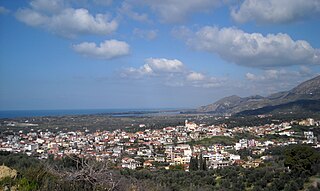
Zacharo is a town and municipality in western Peloponnese, Greece. Administratively, it belongs to the regional unit of Elis in West Greece. Zacharo is situated on the coast of the Gulf of Kyparissia, a part of the Ionian Sea. The mountain Lapithas is to the north, and the Minthi is to the east. Northwest of the town, between mount Lapithas and the sea, is the Kaiafas Lake. Zacharo is 18 km south of Olympia, 28 km southeast of Pyrgos, 65 km northwest of Kalamata and 65 km west of Tripoli. The town is crossed by the Greek National Road 9/E55, that links Patras with Kalamata.

Arbequina is a cultivar of olives. The fruit is highly aromatic, small, symmetrical and dark brown, with a rounded apex and a broad peduncular cavity. In Europe, it is mostly grown in Catalonia, Spain, but it is also grown in Aragon and Andalusia, as well as California, Argentina, Chile, Australia and Azerbaijan. It has recently become one of the dominant olive cultivars in the world, largely under highly intensive, "super high-density" plantation.

The orange is the fruit of various citrus species in the family Rutaceae ; it primarily refers to Citrus × sinensis, which is also called sweet orange, to distinguish it from the related Citrus × aurantium, referred to as bitter orange. The sweet orange reproduces asexually ; varieties of sweet orange arise through mutations.
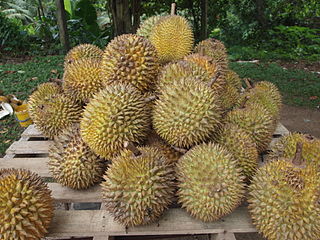
The durian is the fruit of several tree species belonging to the genus Durio. There are 30 recognised Durio species, at least nine of which produce edible fruit, with over 300 named varieties in Thailand and 100 in Malaysia, as of 1987. Durio zibethinus is the only species available in the international market: other species are sold in their local regions. It is native to Borneo and Sumatra.

The Kalamata olive is a large, dark purple olive with a smooth, meaty texture, named after the city of Kalamata in the southern Peloponnese, Greece. Often used as table olives, they are usually preserved in wine vinegar or olive oil. Typically the term "Kalamata" legally refers to a region of Greece where these olives are grown, however a few countries use the name for such olives grown anywhere, even outside of Greece. Within the EU the name is protected with PDO status, which means in the EU the name can only be used for olives from the Messinia region of Greece. Olives of the same variety grown elsewhere are marketed as Kalamon olives in the EU and, sometimes, elsewhere.

An apple is an edible fruit produced by an apple tree. Apple trees are cultivated worldwide and are the most widely grown species in the genus Malus. The tree originated in Central Asia, where its wild ancestor, Malus sieversii, is still found today. Apples have been grown for thousands of years in Asia and Europe and were brought to North America by European colonists. Apples have religious and mythological significance in many cultures, including Norse, Greek, and European Christian tradition.

The Bosana is the most common cultivar of olives in Sardinia. It makes up over 50% of the olive production on the island. The etymology of the name is uncertain, but it could refer to an alleged origin in the territory of Bosa. It is maintained, however, that the cultivar is of Spanish origin. It is used primarily for oil, but can also be eaten. The Bosana is a variety well adapted to less hospitable environments.
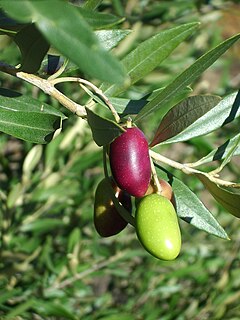
The Lucques is a cultivar of olives grown primarily in Languedoc in France. It is primarily used as a green table olive. It can also produce high quality oil, but this is hard to extract. Though vulnerable to certain pests, it is relatively resistant to cold and drought.
The Olivière is a cultivar of olives grown primarily in the Pyrénées-Orientales region of southern France, where it is the most prevalent variety of olives. It is highly valued for its exceptionally high tolerance to cold. The Olivière is primarily used for oil, and even though the fruit yields a low percentage, the trees carry large quantities of olives, and the oil is of high quality.

Agriculture in Spain is important to the national economy. The primary sector activities accounting for agriculture, husbandry, fishing and silviculture represented a 2.7% of the Spanish GDP in 2017, with an additional 2.5 % represented by the agrofood industry.
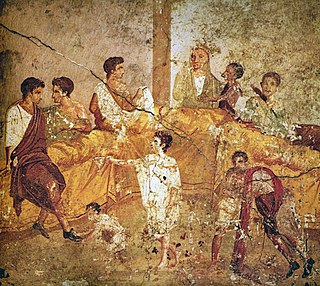
Food and dining in the Roman Empire reflect both the variety of food-stuffs available through the expanded trade networks of the Roman Empire and the traditions of conviviality from ancient Rome's earliest times, inherited in part from the Greeks and Etruscans. In contrast to the Greek symposium, which was primarily a drinking party, the equivalent social institution of the Roman convivium was focused on food. Banqueting played a major role in Rome's communal religion. Maintaining the food supply to the city of Rome had become a major political issue in the late Republic, and continued to be one of the main ways the emperor expressed his relationship to the Roman people and established his role as a benefactor. Roman food vendors and farmers' markets sold meats, fish, cheeses, produce, olive oil and spices; and pubs, bars, inns and food stalls sold prepared food.

Italy produces many food products.

The Bidni, which is also referred to as Bitni, is an olive cultivar from the Mediterranean island of Malta. The fruit is small in size, hearty with a "violet colour", and is renowned for its superior oil which is low in acidity. The latter is generally attributed to the poor quality alkaline soil found on the Maltese Islands. As an indigenous olive cultivar, the Bidni has developed a unique DNA profile, and is believed to be among the most ancient species on the island, triggering local authorities to declare some of these ancient trees as "national monuments", and as having an "Antiquarian Importance", a status which is enjoyed by only a handful of other species.

















